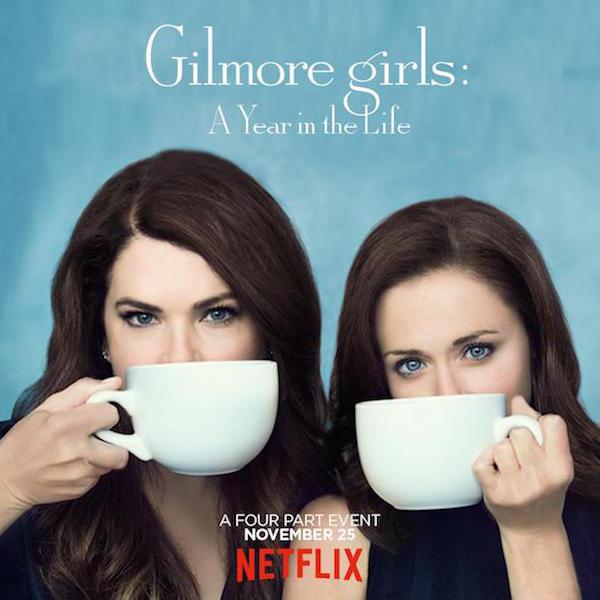Under Review: “Gilmore Girls: A Year in the Life” turns characters upside down

“A Year in the Life” was a four-part Netflix exclusive that premiered in November.
January 3, 2017
The following review may contain spoilers of the recent Gilmore Girls miniseries.
Nine years after its final season, “Gilmore Girls” is back. The idyllic Connecticut town of Stars Hollow has not changed in the slightest since the show’s end in 2007. Neither, it seems, have its inhabitants, who have apparently not grown up since we last saw them. And therein lies one of the central flaws of “Gilmore Girls: A Year in the Life,” the long-awaited four-part miniseries set ten years after the end of the original show.
“Gilmore Girls” is a beloved comfort show for many reasons: the close bond between mother and daughter, the witty script, the aspirational characters, and the engaging but relatively low-stakes drama. As a fellow nerdy girl, I idolized Rory, who was like me in many ways—bookish, driven, journalistically inclined—but always smarter, prettier, more sensible. She was the foil to flighty Lorelai, who was less tightly wound but similarly successful and energetic.
The series opens with Rory and Lorelai back in the town gazebo, trading their signature rapid-fire banter. Rory, a freelance journalist, divides her time between London and New York. Lorelai and Luke are still together but unmarried. This is an infrequent reunion for Rory and Lorelai, formerly an inseparable duo.
In the revival, Lorelai and Rory are, simply put, a mess. Rory has only a smattering of well-received articles to show for ten years of work, and at 32, has no stable job prospects. She has dated the nice if forgettable Paul for two years because she continually forgets to break up with him. Lorelai is unsure of her relationship with Luke though they’ve persevered for the last decade.
The emotional core of the miniseries lies in the death of Richard, Lorelai’s father. Each one of the Gilmore women are forced to reckon with their grief: Emily, his widow, lashes out at her daughter Lorelai in perhaps the grimmest moment in Gilmore history, Lorelai embarrasses herself at the funeral by airing the family’s dirty laundry, and Rory is forced to confront her age and lack of significant progress.
Emily Gilmore’s storyline is the redeeming thread that holds the series together. I truly sympathized with her as she navigated the grief and confusion that followed the death of her husband, and cheered as she cast off the artifice of her old life and moved to Nantucket. The last episode of the miniseries held reconciliation for Lorelai and Emily, and Lorelai’s monologue of a happy memory with her father is easily the most touching moment of the show.
Stars Hollow is a graveyard of broken dreams for its female inhabitants. Rory had it all in the original series. She seemed destined to improve upon her mother’s mistakes by attending Yale and launching the career of her dreams. But the Rory that we see in the miniseries is stagnant. She, like Lorelai, has never truly grown up, and her moral failings, such as her affair with an engaged ex, can no longer be dismissed as youthful indiscretion. As the unpaid editor of the Star’s Hollow Gazette—a far cry from her former New York Times aspirations—she replaces coffee with lunchtime alcohol. She is immature and entitled, and when her mother balks at her sudden scheme to write the story of their lives, “Little Women”-style, Rory throws a temper tantrum.
Lane Kim, Rory’s best friend and a former aspiring drummer, works at her overbearing mother’s antique store. Lorelai watches her friends leave her one by one, and comes to realize that she and Luke are living separate lives, leading to a truly bizarre plot point in which Lorelai decides to literally take a hike. Rory is the saddest of all: she is doomed to repeat her mother’s mistakes, having children with a man who, like her own father, is irresponsible and likely unable to cope with fatherhood.
Stars Hollow is to Lorelai and Rory what Never-Land is to Peter Pan: a refuge from the struggles of the outside world, and especially a refuge from adulthood. For all her strengths, Lorelai is at her core a woman-child, and nowhere is this illustrated more clearly than in her interactions with her mother Emily, in which she reverts to the petulant 16 year old that she was when she became pregnant with Rory and ran away. Rory lives in her mother’s house in her old bedroom, and continues to associate with the exciting but aimless friends of her college years.
The best explanation for the character inconsistencies in “Gilmore Girls: A Year in the Life” is that this is director Amy Sherman-Palladino’s attempt to close the show on her own terms, after leaving the show before its final season. But she failed to acknowledge that the characters have lived a whole decade since the show’s seventh and last season, ten years that would have (hopefully) brought at least some increasing maturity and professional accomplishment.
Rory and Lorelai’s mistakes would be acceptable or at least understandable had this miniseries occurred even five years earlier. Of course, it’s unfair to put the Rory and Lorelai of old on a pedestal. But now, their foibles render them pathetic rather than relatable.




